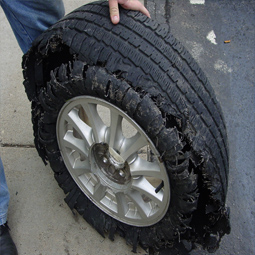 After the initial buzz of buying a new car wears off, it becomes all too easy to neglect some important parts of maintaining your car. Life often gets in the way, and you find that keeping it looking shiny and new doesn’t matter as much as it did when you first bought the car. The problem is that cars are carefully crafted pieces of machinery, and small issues can become big ones without you noticing. Find out some ways you could be hurting your car without realizing it below.
After the initial buzz of buying a new car wears off, it becomes all too easy to neglect some important parts of maintaining your car. Life often gets in the way, and you find that keeping it looking shiny and new doesn’t matter as much as it did when you first bought the car. The problem is that cars are carefully crafted pieces of machinery, and small issues can become big ones without you noticing. Find out some ways you could be hurting your car without realizing it below.
Not Checking Tire Pressure
Checking the tire pressure is one of the easiest things to do on a car, but issues with tire pressure often get overlooked until the point that they pose issues to either safety or performance. Ensure you’re proactive instead of reactive by checking tires regularly, and you can fix any tire inflation issues before they cause further damage.
The more you use your tires, the more pressure they lose. Eventually, the tires reach a point where they become under-inflated, and underinflated tires pose many possible hazards including blowouts and premature wear.
You can check your tires within five minutes with a pressure gauge, and if you find that the pressure is too low, simply drive to the nearest service station to inflate them. Carry out this check once each month for maximum safety. You can find the recommended tire pressure range in your owner’s manual, and you should ensure not to overcompensate for under-inflation by putting too much air in the tires.
Ignoring the Check Engine Light
Drivers often ignore the check engine light under the assumption that because there are no perceptible issues with how the car drives, then there must be nothing wrong with the engine. If you see a check engine light flashing, don’t ignore it. No matter how small the issue, a car engine is a complex system requiring the smooth operation of many small parts to work correctly. You should get any issues sorted out before you experience a system breakdown in the middle of the road, which besides being embarrassing is extremely dangerous.
Going Too Fast Over Speed Bumps
Authorities often place speed bumps in an area where they believe driving at a slower speed is necessary to ensure adequate safety. But speed bumps do not equate to speed limits, and you might feel tempted to ignore speed bumps along your route sometimes, especially when you’re in a hurry. Driving too fast over speed bumps can spell disaster for your car over time, though.
Firstly, the repeated battering that your car’s suspension system receives while you drive too fast over bumps eventually wears the shocks down until they need replacing. Secondly, driving too fast over speed bumps causes damage to the undercarriage of the car. Slow down and drive at the recommended speed when you encounter speed bumps.
These three issues represent some of the most common ways drivers harm their vehicles without realizing the damage they’re causing. Now that you know about these issues, you can take proactive steps to avoid them.
Image by The Tire Zoo is licensed under CC BY 2.0





